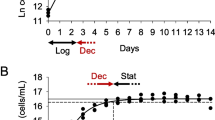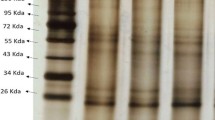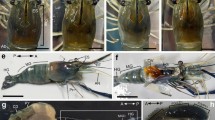Abstract
For pearl culture, the pearl oyster is forced open and a nucleus is implanted into the gonad with a mantle graft. The outer mantle epithelial cells of the implanted mantle graft elongate and surrounding the nucleus a pearl sac is formed. Shell matrix proteins secreted by the pearl sac play an important role in the regulation of pearl formation. Recently, seven shell matrix proteins were identified from the pearl oyster Pinctada fucata. However, there is a paucity of information on the function of these proteins and their gene expression patterns. Our study aims to elucidate the relationship between pearl type, quality, and gene expression patterns of six shell matrix proteins (msi60, n16, nacrein, msi31, prismalin-14, and aspein) in the pearl sac based on real-time PCR analysis. After culturing for about 2 months, the pearl sac tissues were collected from 22 individuals: 12 with high quality (HP), nine with low quality (LP), and one with organic (ORG) pearl formation. The surface of each of the 12 HP pearls was composed only of a nacreous layer; in contrast, that of the nine LP pearls was composed of nacreous and prismatic layers. The six target gene expressions were detected in all individuals. However, delta threshold cycle (ΔC T) for msi31 was significantly higher in the HP than in the LP individuals (Mann–Whitney’s U test, p = 0.02). This means that the relative expression level of msi31, which constitutes the framework of the prismatic layer, was higher in the LP than in the HP individuals.





Similar content being viewed by others
References
Aoki S (1966) Comparative histological observations on the formation of nacreous prismatic and periostracal pearls. Bull Japan Soc Sci Fish 32:31–33 (in japanese)
Arnaud-Haond S, Goyard E, Vanau V, Herbaut C, Prou J, Saulnier D (2007) Pearl formation: persistence of the graft during the entire process of biomineralization. Mar Biotechnol 9:113–116
Belcher A, Wu MH, Christensen RJ, Hansma PK, Stucky GD, Morse DE (1996) Control of crystal phase switching and orientation by soluble mollusc-shell proteins. Nature 381:56–58
Bookout AL, Mangelsdrf DJ (2003) Quantitative real-time PCR protocol for analysis of nuclear receptor signaling pathways. Nucl Recept Signal 1:e012
Checa A (2000) A new model for periostracum and shell formation in Unionidae (Bivalvia, Mollusca). Tissue Cell 32:405–416
Falini G, Albeck S, Weiner S, Addadi L (1996) Control of aragonite or calcite polymorphism by mollusk shell macromolecules. Science 271:67–69
Fang Z, Feng Q, Chi Y, Xie L, Zhang R (2008) Investigation of cell proliferation and differentiation in the mantle of Pinctada fucata (Bivalve, Mollusca). Mar Biol 153:745–754
Garcia-Gasca AJ, Ochoa-Baez RI, Betancourt M (1994) Microscopic anatomy of the mantle of the pearl oyster Pinctada magatianica (Hanley, 1856). J Shellfish Res 13:85–91
Hongyan M, Ahang B, Lee IS, Zuolu Q, Zhangrfa T, Shuheng Q (2007) Aragonite observed in the prismatic layer of seawater-cultured pearls. Front Mater Sci China 1:326–329
Kawakami KI (1953) Studies on pearl-sac formation II. The effect of water temperature and freshness of transplant on pearl-sac formation. Ann Zool Japan 26:217–223
Livak KJ, Schmittgen TD (2001) Analysis of relative gene expression data using real-time quantitative PCR and the 2(-Delta Delta C(T)) method. Methods 25:402–408
Machii A, Nakahara H (1967) Studies on the histology of pearl sac. Bulletin of Natural Pearl Research Laboratory, Japan 2:107–112 (in Japanese)
Marios AC, Morse DE (1988) Purification and characterization of calcium-binding conchiolin shell peptides from the mollusc, Haliotis rufescens, as a function of development. J Comp Physiol B 157:717–729
Miyamoto H, Miyashita T, Okushima M, Nakano S, Morita T, Matsushiro A (1996) A carbonic anhydrase from the nacreous layer in oyster pearls. Proc Natl Acad Sci U S A 93:9657–9660
Munetomo A (1994) The common-sense of pearl, Ehime Pearl Committee, Ehime. 119p (in Japanese)
Samata T, Hayashi N, Kono M, Hasegawa K, Horita C, Akera S (1999) A new matrix protein family related to the nacreous layer formation of Pinctada fucata. FEBS Lett 462:225–229
Southgate PC, Lucas JS (2008) The pearl oyster. Elsevier, Oxford, 573p
Sudo S, Fujikawa T, Nagakura T, Ohkubo T, Sakaguchi K, Tanaka M, Nakashima K, Takahashi T (1997) Structures of mollusc shell framework proteins. Nature 387:563–564
Suzuki M, Murayama E, Inoue H, Ozaki N, Tohse H, Kogure T, Nagasawa H (2004) Characterization of Prismalin-14, a novel matrix protein from the prismatic layer of the Japanese pearl oyster (Pinctada fucata). Biochem J 382:205–213
Takeuchi T, Endo K (2006) Biphasic and dually coordinated expression of the genes encoding major shell matrix proteins in the pearl oyster Pinctada fucata. Mar Biotechnol 8:52–61
Tsukamoto D, Sarashina I, Endo K (2004) Structure and expression of an unusually acidic matrix protein of pearl oyster shells. Biochem Biophys Res Commun 320:1175–1180
Wada K (1962) Biomineralization studies on the mechanism of pearls formation. Bull Natl Pearl Res Lab 8:948–1059 (in Japanese)
Wada K (1999) Science of the pearl oyster. Shinju Shinbunsha, Tokyo. 336p. (in Japanese)
Zhang Y, Xie L, Meng Q, Jiang T, Pu R, Chen L, Zhang R (2003) A novel matrix protein participating in the nacre framework formation of pearl oyster Pinctada fucata. Comp Biochem Physiol B 135:565–573
Acknowledgments
We wish to express our sincere thanks to K.T. Wada, of the Shima of Ugata, for valuable comments on this study. Thanks are also due to K. Kawamura, Faculty of Bioresources of Mie University, and K. Hanyu, Mie Prefecture Fisheries Research Institute, for their moral support throughout the study.
Author information
Authors and Affiliations
Corresponding author
Rights and permissions
About this article
Cite this article
Inoue, N., Ishibashi, R., Ishikawa, T. et al. Can the Quality of Pearls from the Japanese Pearl Oyster (Pinctada fucata) be Explained by the Gene Expression Patterns of the Major Shell Matrix Proteins in the Pearl Sac?. Mar Biotechnol 13, 48–55 (2011). https://doi.org/10.1007/s10126-010-9267-1
Received:
Accepted:
Published:
Issue Date:
DOI: https://doi.org/10.1007/s10126-010-9267-1




